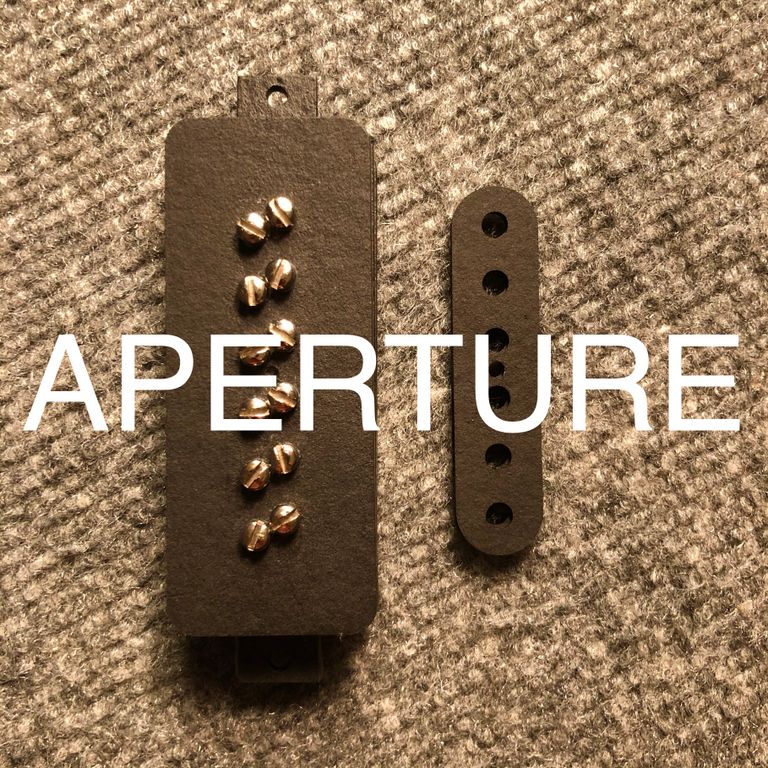
Aperture
APERTURE - the length of vibrating string being sensed by the pickup. Aperture is a word typically used in photography to describe the opening of the lens?? Photographers can correct me if I’m off here. It works the same way with pickups: the width of the magnetic field and the width of the coil is a HUGE determining factor in the tone of a pickup. Example: a P90 is wider than a Strat pickup which means that it has a larger aperture than a Strat pickup and therefore has a bigger tone than a Strat pickup (pictured is my new Alternate Dimension dogear P90 next to some Strat flatwork). I use this word A LOT, far more than other pickup makers (most don’t use or even know this term), because with the new pickups I’m making (Alternate Dimension line), I’m pushing the limits of the size of these pickups, filling the entire pickup routs with wire to get the most tone out of those holes in your guitars. For example: my new Alternate Dimension P90s don’t fit inside of P90 covers, they’re the size of P90 covers which gives me nearly another 1/8” of room to expand the coil to fatten the tone up. That 1/8” increase in aperture makes a big difference in tone... for a bigger tone.
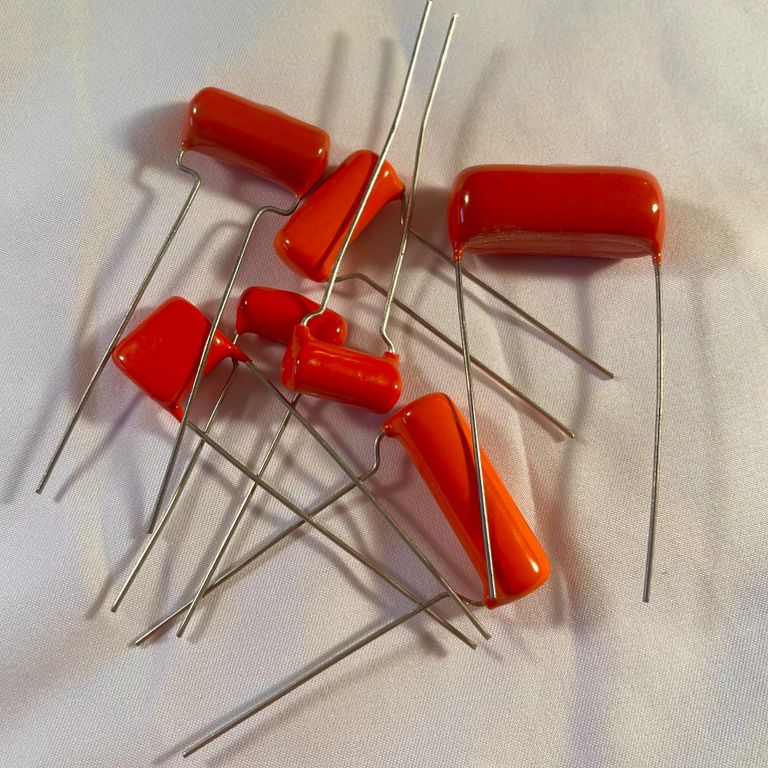
Capacitors
In the real world, capacitors store voltage; in the guitar world, capacitors store treble frequencies. In a tone control, the capacitor is essentially stealing treble frequencies and sending them to ground (the abyss, throwing them away). Lower value capacitors, like 0.010uf and 0.015uf, only grab the upper treble frequencies; 0.022uf grabs all the treble frequencies; 0.047uf grabs the treble frequencies and some of the upper mids; 0.068uf grabs the treble and upper mid frequencies; 0.100uf capacitors grab the treble frequencies and most of the mid frequencies leaving you with only bass frequencies. 0.022uf capacitors are the most popular; 0.047uf capacitors are the second most popular but too dark for most players. My recommendation is to use a capacitor that hits your maximum needs when the tone control is rolled back all the way. For me, that’s typically a 0.010uf for a neck pickup and 0.015uf for a bridge pickup. If you’re a “never use the tone control” player, try a 0.010uf capacitor… you might actually start using it.
Brands, style, monetary value
The $0.20 ceramic capacitors don’t sound good; definitely replace those. There are many different brands and styles of paper-in-oil capacitors (orange drop, bumblebee, etc.), and they vary in price from about $4 to $75. They all sound about the same (as long as you’re comparing the same values): you’re not going to hear a $46 difference between the $50 NOS (New Old Stock) capacitors and the affordable Sprague Orange Drop capacitors.
Treble bleed circuit
Treble bleed circuits are very low value capacitors (sometimes with a resistor) that bridge between the input and output lugs on volume pots. The idea is that it stores the upper treble frequencies while the remaining frequencies are sent to ground when you roll the volume back (turning the volume down except for the upper treble frequencies). This is absolutely beneficial with machine wound pickups because they’re muddy and rolling the volume back makes your tone even muddier. Treble bleed circuits are not only not necessary with handwound pickups but they’re also going to change your tone negatively, even when your volume controls are turned up all the way. I’ve had dozens of people ask me about treble bleed circuits, I tell them what you just read, they install them anyways, then email me to say I was right after they remove them from their guitars. If you’re playing Stonewall Pickups, skip the treble bleed circuits.
It’s also important to note that with machine wound pickups, the tone control just makes your tone muddy (should call it the “no tone” control). With boutique handwound pickups, however, the tone control is actually useful: your tone retains clarity and string-to-string definition while you roll those treble frequencies away.
Coil Tap vs Coil Split
There’s a good possibility that you’ve heard of coil tapping but not coil splitting and unfortunately, have the terminology backwards. Coil splitting is for humbuckers; coil tapping is for single coils.
Coil splitting is turning one of the two humbucker coils off, essentially splitting the humbucker into a functional coil and a coil that’s off; there is no tapping in that process. Coil splitting.
Coil tapping is a feature that a pickup maker can build into a single coil pickup; not every single coil pickup can be tapped, in fact it’s quite rare. A very easy example: a single coil pickup that is normally wound 10,000 turns or wire… that pickup can be wound 7,000 turns first, tie that off, then wind another 3,000 turns. There will be three wires coming from that pickup, I use black, white, and yellow: the black wire is the start (ground) and the white wire is the finish(hot), the yellow wire is connected to the point where the coil was tied off at 7,000 turns (tap). Wired that way, the pickup functions fully with all 10,000 turns active. If you were to switch out the white wire for the yellow wire, you are “tapping” into the middle of that coil at 7,000 turns. Coil tapping. Not nearly as common but a really fun way to add an extra useful tone to your guitar.
I have no idea why everyone got it wrong, decades ago. It’s not like “coil tapping” is easier to say, both terms have the same number of syllables. It makes no sense to me and I’ll probably never understand why. All pickup makers know the difference but some of the bigger companies intentionally use the term “coil splitting” for humbuckers because it’s easier than correcting and educating the customers. I see brand new guitars with humbuckers for sale with decals that state “coil tapping”… which is obviously incorrect. What would that same company do if they released a guitar with tapped single coils?? How would they advertise that feature?? These companies are contributing to the misinformation of guitars which makes it more difficult for guitarists to fully understand their instruments. If every pickup maker, guitar builder, guitar tech, guitar salesman, and guitar teacher were to all switch to using the correct terminology, this bad habit would be eliminated within a decade. But that’s not going to happen. So now that you know the right terminology, please use them correctly and let others know, politely, when they’ve made a mistake. This won’t be corrected in my lifetime but maybe we can get it started.
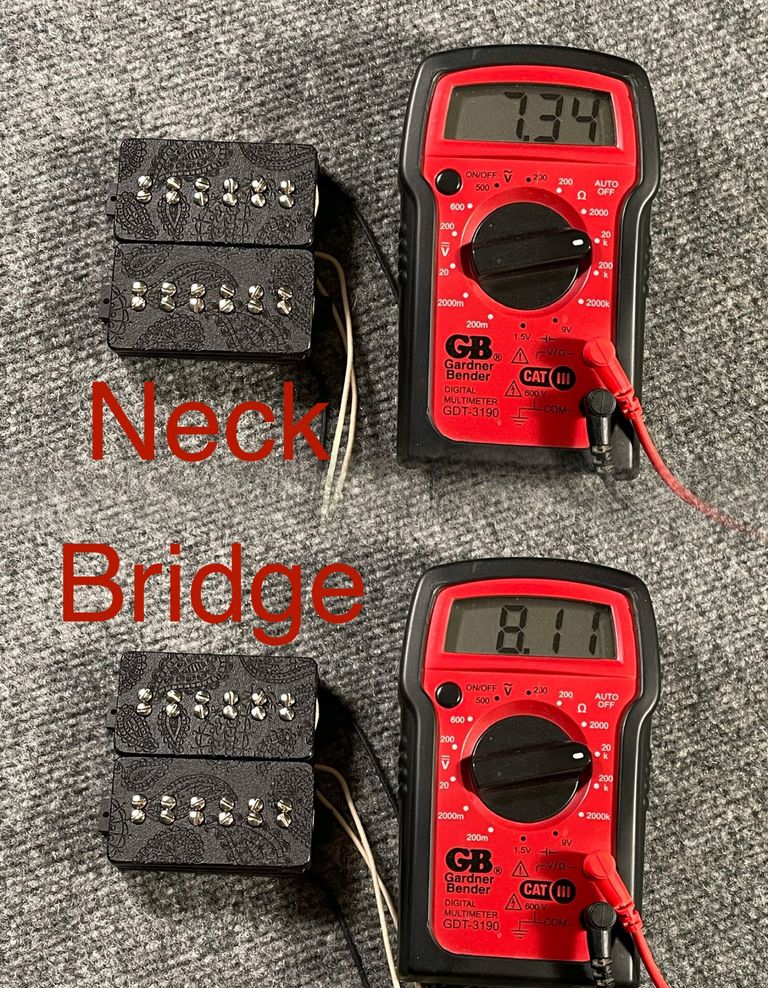
DC Resistance
DC resistance is what most pickup companies use as specs for pickup listings but DC resistance means (practically) nothing; what we actually hear is the number of turns of wire, the mass of copper wire, the shape of the coil(s), and the magnetic field. DC resistance is the measurement of the length of wire, in resistance, at rest. But it’s impossible to hear what a pickup sounds like at rest; like “what’s the sound of one hand clapping” or “if a tree falls in the woods and no one is around to hear it, does it make a sound??” For example: two pickups at 6.5k resistance with alnico V rod magnets: one wound with 42 AWG (standard), the other wound with 38 AWG (very thick); the one with 42 AWG is a Strat pickup but the one with 38 AWG will need two and a half times as many turns to reach the same resistance and would be about four times the size... as a result, it will sound hotter because it has so many more turns of wire and it will sound darker because of the mass of copper and the opposing magnetic currents caused by that much copper (eddy currents, the good kind… that’s a future post). Also, ambient temperature effects the DC resistance readings of pickups: reading a pickup that just came out of hot wax (wax potting) will read “hotter” (higher resistance) than at room temperature and reading the same pickup that’s been out in a car in the winter will read at a lower resistance. The pickup will actually sound exactly the same regardless of what the temperature is... because what we hear is the number of turns of wire, eddy currents, aperture, and magnetic field. The DC resistance reading we’ve been using in the pickup industry forever means nothing. Somehow, decades ago, we (guitarists) started saying “output” when we meant “resistance” but also when referencing volume. Volume output is effected most efficiently by pickup height; changing resistance doesn’t change volume nearly as much as you think: lower output is cleaner and brighter, higher output is darker and more overdriven. Raising the pickup closer to the strings will be louder.
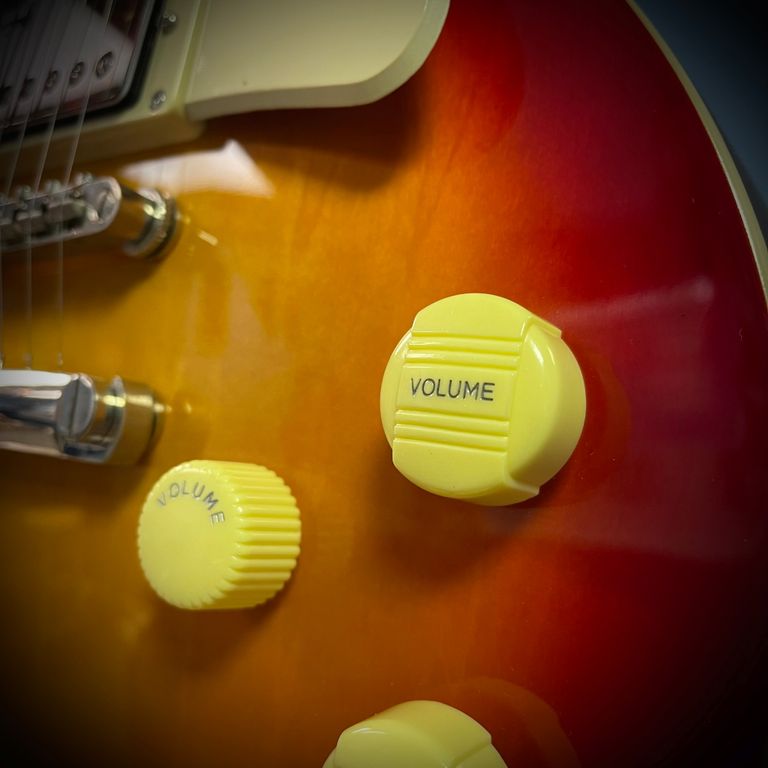
Dynamics… play more expressively
Dynamics in music refers to how quiet or loud the musician(s) is playing. As a guitarist, this should be controlled by your strumming hand, not your volume controls or volume pedal… at least not exclusively. However, stock pickups and machine-wound pickups aren’t capable of allowing the player to perform dynamically.
Dynamics is “quiet” and “loud” and everything in between. In musical notation (Italian), it’s called “piano” and “forte”, respectively. Did you know that the full name for the piano (instrument) is “pianoforte”?? That’s a truth-fact. Before the piano, the keyed instrument of choice was the harpsichord which, when a key was hit, a quill would pluck that string; hit the key hard and you still played that string, hit the key soft and it didn’t make a sound. There was no dynamic expression with a harpsichord. The piano uses a hammer to hit the strings: hit the key softly and you hear the quietest sounds, hit the key hard and it’s exceptionally loud. A pianoforte plays both piano and forte. A handwound pickup can do the same thing. Why do players have a difficult time with this concept?? Manufactured guitars have machine wound pickups which are not very dynamic at all. Imagine a musician who has only played the harpsichord sits at the piano for the very first time... will his playing on the piano be dynamic?? Probably not. Nearly every electric guitarist has been stifled by machine wound pickups and has not had the opportunity to express themselves through the dynamics that we’re all capable of in our fingers. Now, why should playing dynamically be an important skill for every guitarist?? Think back to some of the most fascinating stories you’ve ever heard or monologues in movies and television shows you’ve seen. The person speaking may have a baseline volume but get very quiet for certain moments to express something secretive and also get REALLY LOUD to express the emotion or importance of certain word or sentences. This method of telling a story is more fascinating because the listener is more engaged with the story teller and can be moved more emotionally due to the dynamics in his or her voice. Some of the very best guitar solos are played in the same way. I’m not talking about the technical solos where the goal is to cram as many notes into each beat as possible, I’m talking about solos from the most widely respected electric guitar legends: Jimi Hendrix, Stevie Ray Vaughn, Eric Clapton. Guitar solos in blues and jazz. These aren’t always the fastest but they are the most expressive and, when done correctly, can bring the listener to tears. Playing dynamically in your fingers is not something that is often talked about or taught (can’t even be practiced on guitars with machine wound pickups) but I feel it’s one of the most important skills any guitarist can use. So when I say that Stonewall Pickups has the best dynamics, I have played thousands of pickups of all the brands and independent winders and my pickups can go quieter and play louder and allow the full expression of the player’s hands. Make sure that you try playing dynamically with Stonewall Pickups and add it to your set of skills.
Eddy Currents
What are eddy currents?? This is actually more important than you think. Actually, it's THE question. Asking around, it’s likely that you’ll get an inaccurate answer. I contacted twelve pickup makers (disguised as a guitarist, not as Stonewall) and heard back from nine. “Brass is bad”, to paraphrase eight of them… even though one actually uses brass in their pickups (“don’t buy my pickups because I use brass”??). One did have a better response but nothing about copper… which is actually the most important. But this isn’t about other pickup makers, I just want to demonstrate how misunderstood eddy currents are in the pickup industry.
Eddy currents are weak swirling magnetic currents that are perpendicular to the magnetic field with an opposing polarity caused when introducing a magnet to a nonferrous metal such as copper, brass (which is two-thirds copper), or aluminum. So… I categorize them as “good” eddy currents and “bad” eddy currents, but I think I’m the only one who subdivides eddy current. “Bad” eddy currents are the ones more frequently talked about: brass baseplates, brass covers, even brass screens used as decorative covers all interfere with the magnetic fields and muddies the tone. Like an invisible shield blocking the magnetic field. These create a muddy, muffled tone... like having a conversation with a COVID mask on. Actually, it’s more like covering your amp with a blanket.
More importantly, what I call “good” eddy currents, is actually how magnetic pickups work. Imagine a sheet of copper and moving a strong magnet in front of it, really close but not touching it. You would actually feel physical resistance like drag on the magnet. That’s because of the eddy currents pushing against the magnet. What’s really interesting is that eddy current pushback on the magnet creates an electrical current in the copper. That’s how pickups work!! Except that, in a pickup, the copper is a coil of really thin wire which is wrapped around the magnet(s) (or steel that is magnetized by magnets underneath the coil), which is stationary, and it’s the steel strings vibrating that cause the magnetic fields to move, which cause the eddy currents from the coil to fight back, which creates the signal in the pickup. Did you grasp all that?? Basically, in both examples, the magnetic field moves: in the first example, the magnet is physically moving; in the second example (guitars), the magnet(s) and copper are stationary but the vibrating string(s) causes the magnetic field o move.
Well, that’s how pickups work but not how it affects the tone. If you haven’t already, read my post about how dc resistance means (basically) nothing because I’m going to touch on that some more. Let’s look at the P90: 10,000 turns of 42 AWG comes out to 8k dc resistance. Similarly, the Charlie Christian pickup, which was the precursor to the P90, was 10,000 turns of 38 AWG and comes out to 3k dc resistance. The lower the number, the thicker the wire; higher the number, the thinner the wire. 38 AWG being much thicker than 42 AWG, you can imagine that the Charlie Christian coil is much bigger, being that the number of turns is the same. Tonally, the Charlie Christian pickup is both brighter and fatter sounding than the P90: brighter because it’s lower output; fatter because there’s more copper in that coil which creates more eddy currents… what I call “good” eddy currents because they fatten the tone without making the tone muddy (the way brass does). Let’s look at the opposite: a 3k P90 wound with 42 AWG would be about 3,750 turns… the coil would be smaller than one humbucker coil. Because of that, the resulting tone would be weak, thin, and small. The 3k coil with 42 AWG would be quieter than the 3k coil with 38 AWG because the smaller coil isn’t generating as much of a current.
A perfect example of good eddy currents vs bad eddy currents is my Alternate Dimension T40 pickups vs the original Peavey T40 pickups. At first listen, both sets sound very similar: fat tone with lots of bass response. But as you keep listening, you can hear the differences… the original T40 pickups are muddy and compressed whereas the Alternate Dimension T40 pickups have more clarity and a better dynamic range. That’s all about the eddy currents. The Peavey T40 pickups have brass baseplates and brass covers which darken and muddy the tone. My Alternate Dimension T40 pickups have larger bobbins, and therefore larger coils wound to similar dc resistances but with much thicker wires which increases the good eddy currents and fattens the tone without making the tone muddy.
The bottom line is that bigger coils have a bigger, fuller tone... due to the mass of copper wire. Instead of asking "what's the resistance/"output" of this pickup", we should be asking "how full of copper do you wind that bobbin??" If you're here looking at Stonewall Pickups, the answer is: I fill every bobbin completely with wire... I flavor each version of each pickup with different magnets or different wire gauges for different playing styles but I'm trying to get the most tone out of every pickup rout with the biggest coil possible.
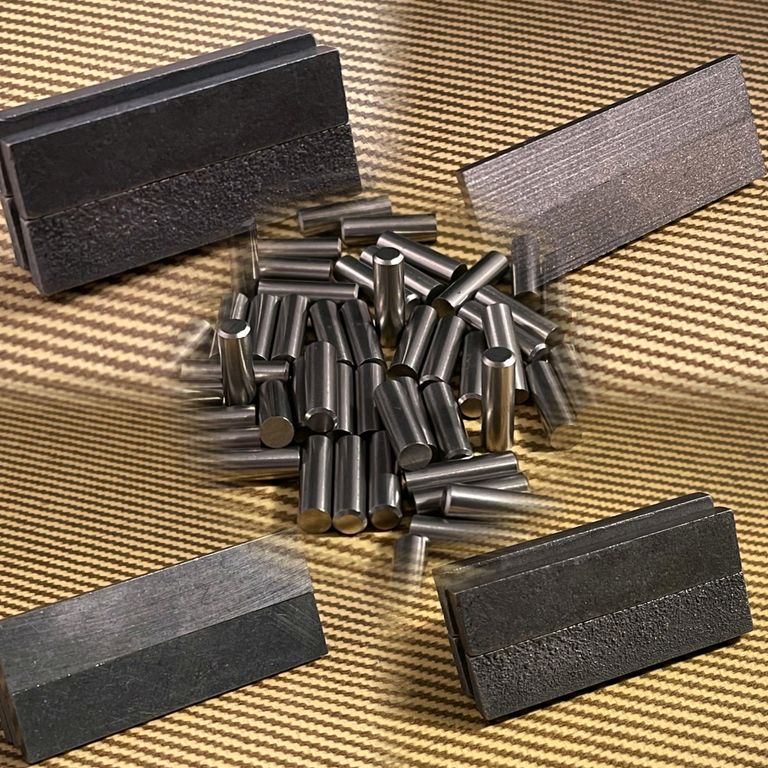
Magnets… about 50% of the tonal equation
The magnet(s) used in a pickup contributes about half of the tone of that pickup. For that reason, it’s important to know the tonal characteristics and strength of each of these magnets. Since alnico V is the most commonly used magnet, it will be the baseline for comparison. Alnico (al•ni•co) is an acronym for aluminum, nickel, and cobalt, three of the metals mixed with iron to make these magnets. Alnico might also contain copper (all except IV) and/or titanium (VI, VIII, & IX).
Alnico II - third weakest magnet. As a bar magnet, it’s my least favorite. Alnico II is brighter with a boost in the upper-mids. I don’t like it by itself in the neck position but works nicely with alnico III in P90s. I have no idea why people think it has a warmer tone. As a rod magnet, it does have a more mellow tone and works well in P-bass and Jazz Bass pickups for a woody tone.
Alnico III - second weakest magnet. Technically not “alnico” since it doesn’t contain cobalt; but it does contain copper so you could call it “alnicu”. Probably the strangest magnets, sonically speaking. The bass response is sweet and kind of spongey in the neck position and the treble frequencies shimmer. However, since it’s so weak, it has a hard time presenting the bass frequencies the same way in the bridge position leaving you with a very treble-forward bridge pickup. Alnico III is one of my favorite magnets for neck pickups. The shimmering treble frequencies are more pronounced in rod magnets in all positions.
Alnico IV - weakest magnet (alnico magnets are not graded in order of strength; the grading almost seems arbitrary). Alnico IV colors the tone the least, really letting the natural tone of the instrument shine through. Fantastic magnet for neck humbuckers, particularly for playing slide.
Alnico V - most popular magnet in guitar and bass pickups. The baseline for this comparison. Strength is dead-center.
Alnico VI - third strongest alnico magnet. Alnico VI is tonally similar to alnico III with shimmering treble frequencies but with a tighter bass response. I prefer it in the neck position but unfortunately, it’s often too strong and could pull the strings down causing fret buzz or interfering with sustain. Therefore, I like it best in the neck position in baritones and basses, when I can.
Alnico VIII - second strongest alnico magnet. The tone is very similar to alnico V but with tighter bass response. Because of its strength, it works particularly well for dropped tunings.
Alnico IX - strongest alnico magnet, just a little bit stronger than ceramic but without the brittle treble frequencies. Still has the warmth of being an alnico magnet. I use this in the highest output humbuckers when other companies would use ceramic magnets.
Ceramic - very strong and very cheap magnet. Typically used in high output humbuckers to enhance the bass and treble frequencies that are lost when a pickup is wound that hot. However, the treble frequencies are brittle and typically unpleasant for most ears.
Neodymium - the strongest magnet available. I’m only just starting to experiment with neodymium magnets.
Pickup Construction - Magnetic Field Design
Magnetic field shape is one of the biggest contributing factors to the tone of pickups.
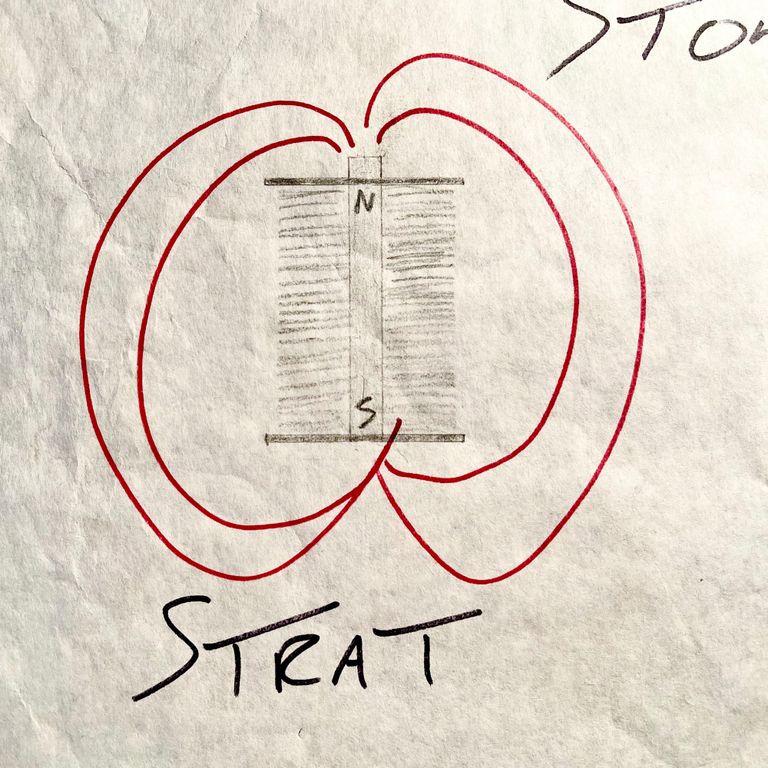
Strat Pickups
Strat pickups have one of the simplest magnetic field designs. Strat pickups (most Fender style pickups) use rod magnets with insulated copper wire wrapped around them several thousand times — all magnets are polarized in the same direction (north up in this drawing). The magnetic field runs from north to south. That’s it. I’m starting with the Strat design because it’s the simplest and therefore, it’s going to be the pickup that I’ll be comparing other pickups to. It’s also important to note (because this will be important in my future posts) that the amount of magnetic field below the coil(s) directly affects the bass response. Jazzmaster and Mustang pickups have the same magnetic field shape. Tele neck pickups pretty much have the same magnetic field shape except that the cover is traditionally made of brass, which darkens and muddies the tone due to eddy currents.
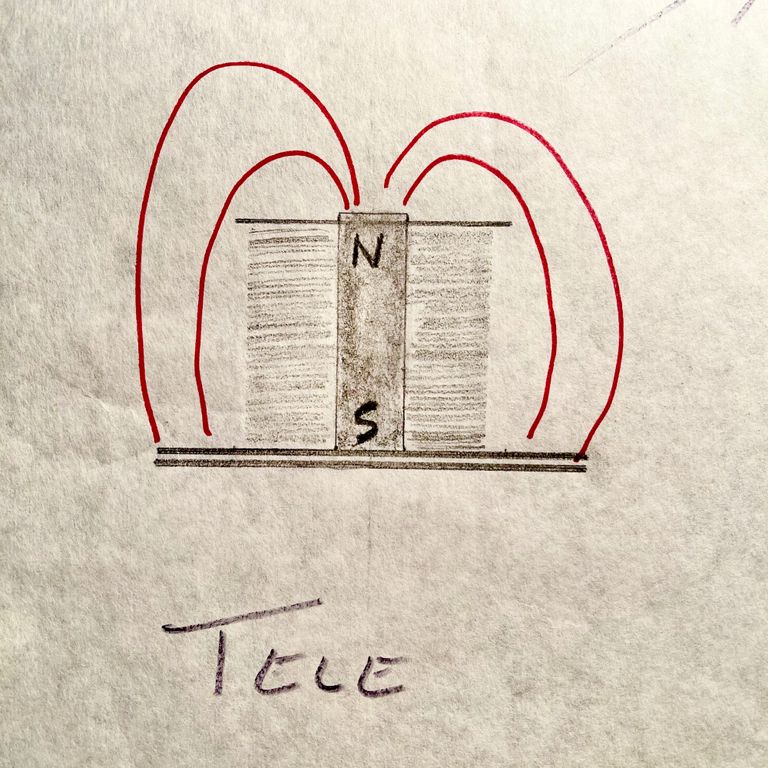
Tele Bridge Pickups
Tele bridge pickups have one of the simplest magnetic field designs; similar to Strat pickups but with a twist. Tele bridge pickups (most Fender style pickups) use rod magnets with insulated copper wire wrapped around them several thousand times — all magnets are polarized in the same direction (north up in this drawing). The magnetic field runs from north to south but the difference is the steel baseplate under the pickup which is magnetized south. This steel baseplate is the defining characteristic in the Telecaster tone: the baseplate is steel, which boosts the strength of the magnets, but not by much; it’s considerably wider than the coil, which widens the magnetic field a bit; but the biggest change to the tone is that the steel baseplate cuts off nearly all of the magnetic field underneath the coil which cuts out a considerable amount of bass response. This is why the Tele bridge pickup is one of the brightest pickups. Jaguar pickups are similar in that they have steel “claws”: U shaped steel baseplates that cut off even more bass response.
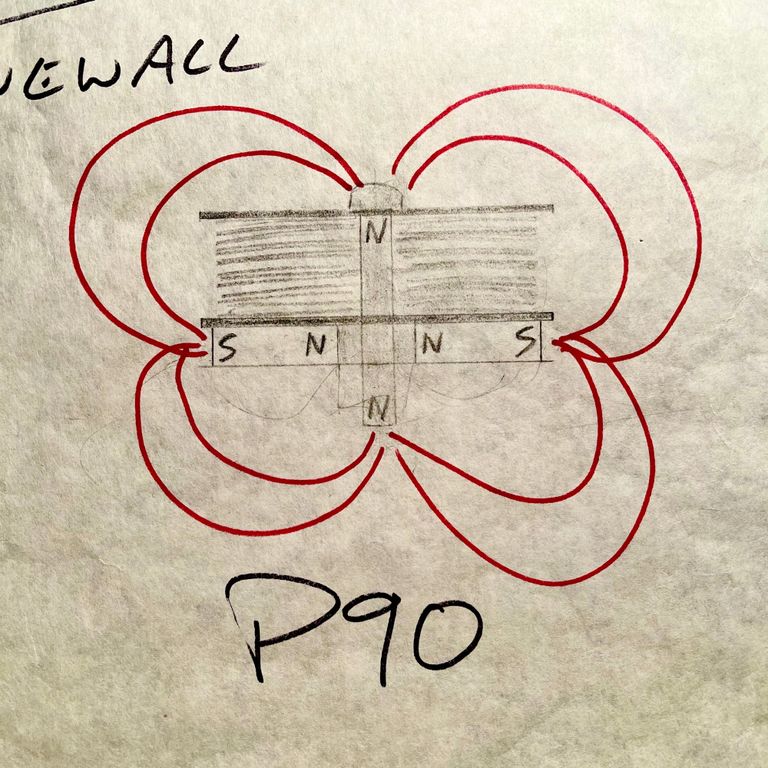
P90 Pickups
P90s have one of the most complex magnetic field designs. P90s are single coil pickups, designed by Gibson guitars in 1946. The difference between Fender pickups and Gibson pickups is: Fender uses rod magnets, Gibson uses steel polepieces to direct the magnetic field(s) of bar magnets. The P90, at first glance, looks like an unnecessarily complex take on the single coil pickup: six steel polepiece screws with insulated copper wire wrapped around them several thousand times; two bar magnets underneath the coil, same polarity facing in, magnetizing all polepiece screws north. These magnetic fields are THE defining tonal characteristic of the P90 pickup; what sets it apart from other single coil pickups. The magnetic field shoots out wider from the tops of the polepiece screws to the outside of the bar magnets, compared to a Strat pickup, but the most important part is that the polepiece screws protrude below the bar magnets, creating a secondary set of magnetic fields which translates into added bass response. This is why P90s, when compared to Fender single coils, have a bigger tone with more bass response. The polepieces must protrude below the bar magnets to get an authentic P90 tone.
This is the same magnetic design for other P90 construction pickups like the Slutty Wolf H90, Signature Strat bridge S90, Signature Tele bridge T90, Signature Jazzmaster bridge J90 and Jazzmaster Bass P90.
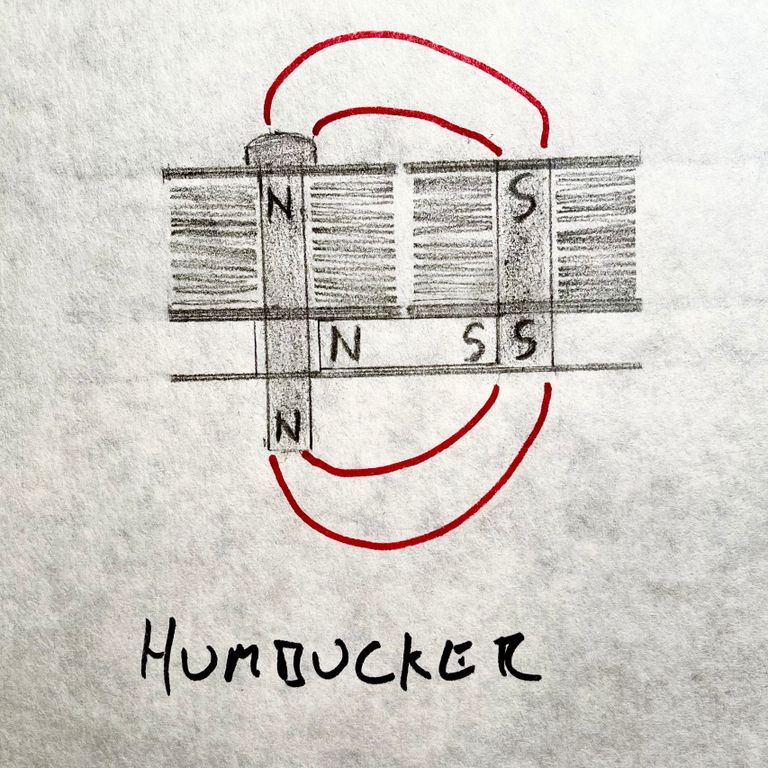
Humbuckers
(traditional)
Humbuckers... it could be said that the magnetic field of the humbucker is simple... however, it is tune’able. The humbucker was designed in the 1950s, and patented in 1955, by Seth Lover at Gibson, and also uses steel polepieces and a bar magnet, similar to the P90. To cancel 60 cycle hum, a pickup must have two coils with opposing polarity and the coils must be wired in opposite directions. This is referred to as RWRP: reverse wound, reverse polarity. Traditionally, one coil has steel polepiece screws and the other coil has steel slugs for polepieces. Notice how the bar magnet fits between the screws and the slugs. In this instance, the screws are polarized as north and the slugs are polarized as south. There is a secondary magnetic field below the coils, like P90s, but since the screws and slugs are different lengths (screws protrude below the bar magnet whereas the slugs do not), the magnetic field is askewed. The screw coil will have more bass response than the slug coil. It’s not very noticeable when the coils are split, switching between the two... but if you were to replace the slug coil with another screw coil, the humbucker has a prominent increase in bass response. Conversely, if you were to replace the screw coil with another slug coil, the humbucker would have a noticeable decrease in bass response. Most of my low output humbuckers are made with twelve screws to prevent them from sounding too bright. I also customize some of my bridge humbuckers with twelve screws when a customer is specifically looking for a bridge pickup with more bass response. (back to humbuckers) When one coil is turned off (coil splitting, not coil tapping... a mistake not corrected decades ago), the magnetic fields remain the same, only present on one side of the coil. Because of this, a split humbucker can not sound like a Fender pickup or a P90, it can only sound like half of a humbucker; the magnetic fields are nothing like that of a Strat pickup or a P90. It is also important to note the width of the magnetic fields: they’re pretty narrow.
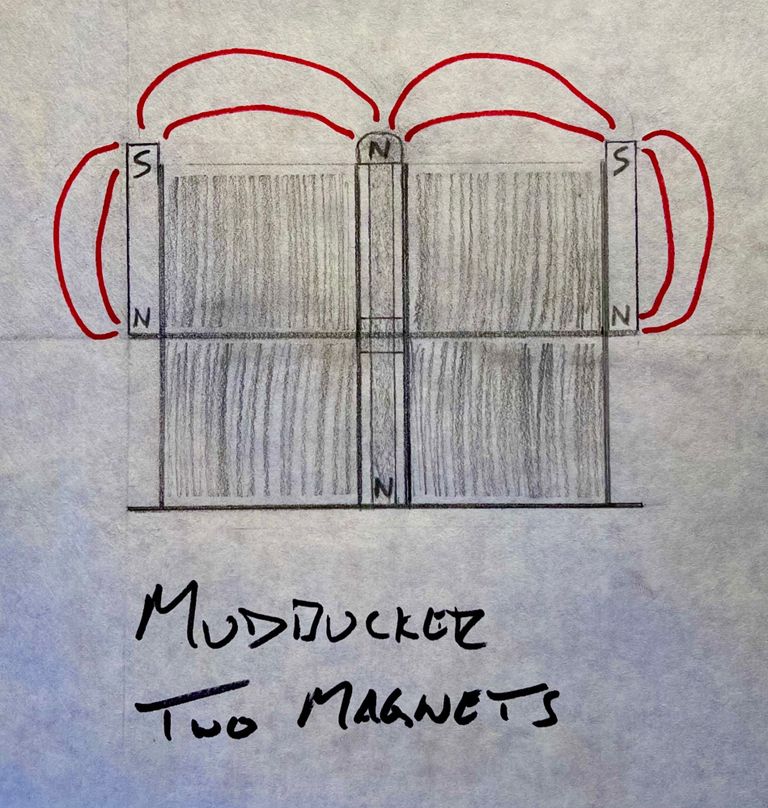
Mudbucker
(2 magnets)
A Mudbucker needs at least two magnets to work but I prefer to use four. With two magnets, there’s just enough to make it work but doesn’t activate the entire width of both coils.
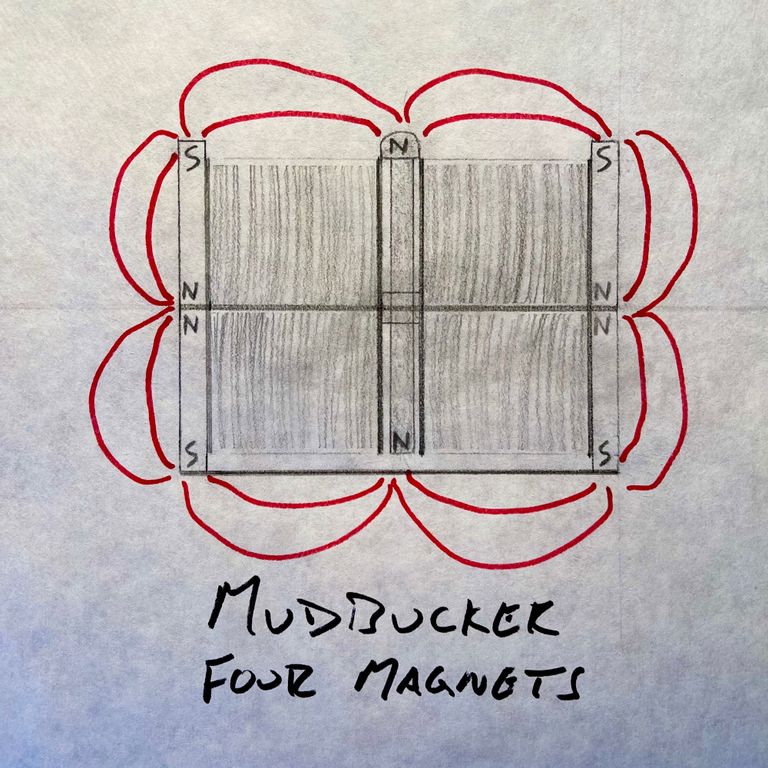
Mudbucker
(4 magnets)
A Mudbucker needs at least two magnets to work but I prefer to use four. That way, it’s like two P90s turned on their sides facing in towards each other. Four magnets engages the full width of both coils and enhances the bass response.
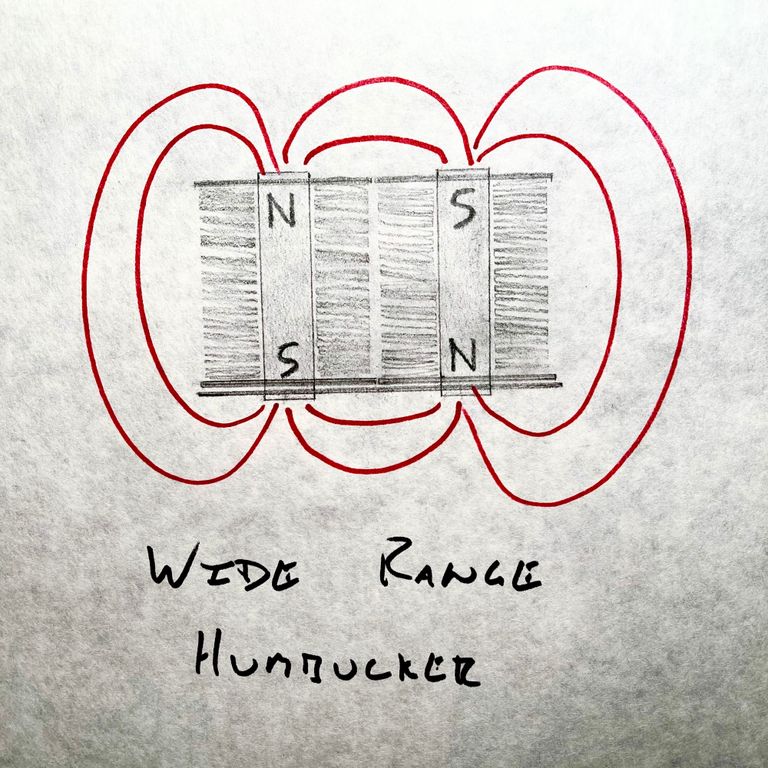
Wide Range
Humbucker
As you can see from the diagram, the Wide Range Humbucker has a considerably larger magnetic aperture when compared to a traditional humbucker. Rod magnets directly underneath the strings make this more responsive but can also potentially pull the strings down causing fret buzz and kill sustain so it’s important not to set these pickups too close to the strings.
Other pickups with this magnetic field design are: the Wide Range Bass Humbucker (obviously), MusicMan bass humbucker, Thunderbird bass pickup, and Firebird guitar pickup (a pickup most often confused with the mini humbucker; the Firebird has this magnetic field shape, the mini humbucker has a traditional humbucker magnetic field shape).
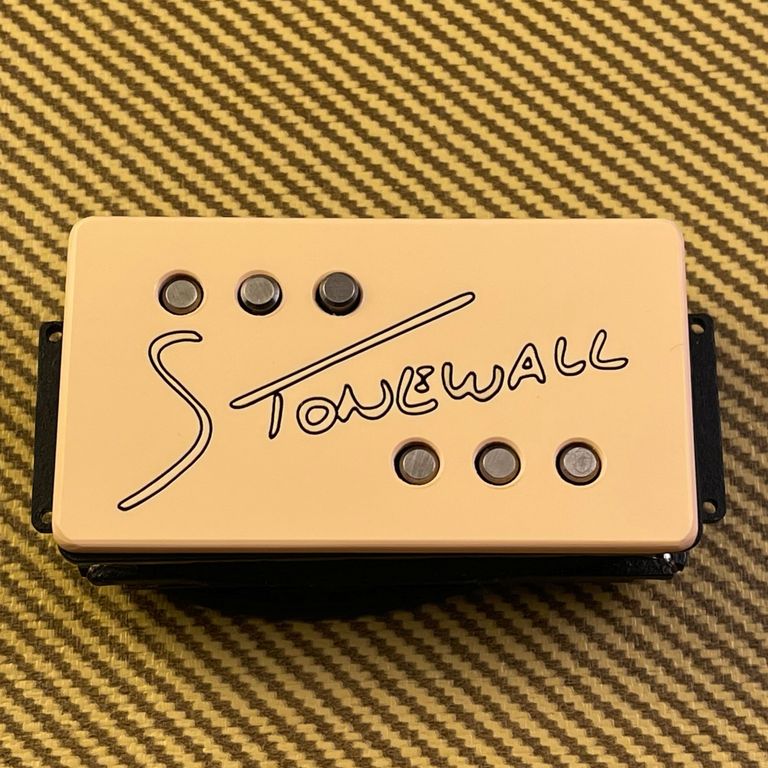
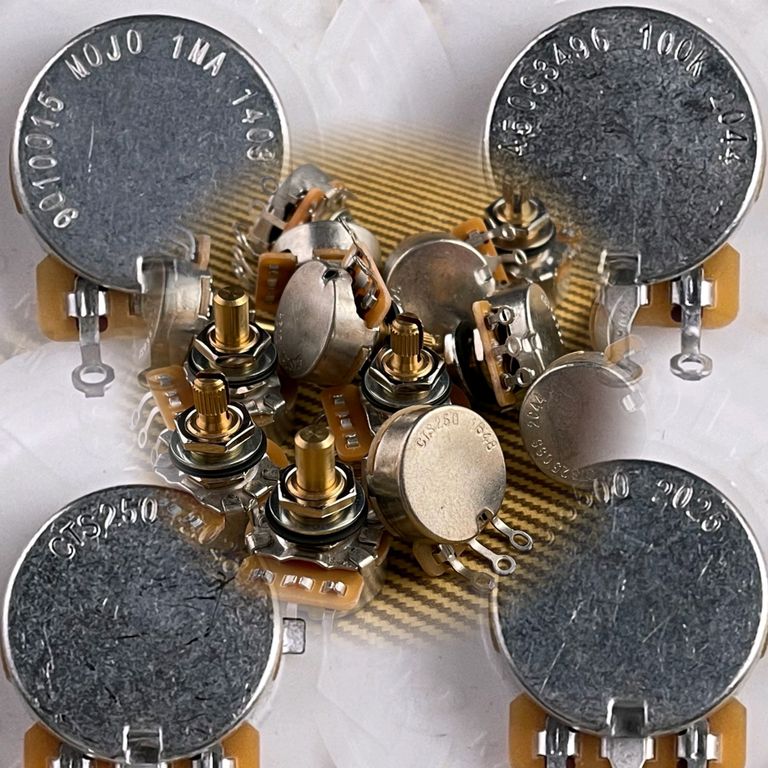
Potentiometer Values
The rule of thumb for pot values is: 500k pots for humbuckers; 250k pots for single coils. This guideline probably came about in the 1950s when the humbucker was invented and then broken in 1958 when Leo put 1meg (1,000k) pots in the Jazzmaster. Over the decades, guitarists turned this guideline into a rule… but it shouldn’t be. In fact, potentiometer values are a great way to fine tune your tone. Let’s start at the beginning: lower value pots will darken your tone; higher value pots will brighten the tone. Strat and Tele pickups are inherently brighter than humbuckers so we typically use 250k pots with those pickups. Humbuckers are two coils wired in series and there’s more magnetic field below the coils which makes them inherently darker which is why we use 500k pots. Jazzmasters and Jaguars use 1meg pots which is what makes them exceptionally bright (surf master, not jazz master). Aside from those offsets, I make a number of pickups where the guideline is less defined and more of a contemplative tonal equation: the Third Eye Single Coil, for example, is a fatter Strat pickup so you could go either way depending on the tonewoods or your tonal preference; the Alternate Dimension Wide Range Humbucker, for example, uses rod magnets like Strat pickups but the coils are wired in series so again, you could go either way. Another example is my VLO P-bass set which requires 100k pots to nail the tone perfectly.
Another point about pot values that unnecessarily got hyped up by the internet: needing all pots to be within a 10% tolerance. Why?? Instead of insisting on all four pots being within 10% tolerance, the different values should be strategically placed within the circuitry: if two pots are 450k and two pots are 550k, the 450k pots could be used for the bridge volume & tone, the 550k pots could be used for neck volume and tone for a more balanced tone… or the other way around for a more extreme tonal difference between the neck and the bridge.
What is important is the quality of the pots. High quality electronics last longer and feel better when you use them. But unlike switches or output jacks, which either makes a connection mechanically or doesn’t, pots actually send the signal through resistance which colors the tone. It’s important that the resistance you’re running your signal though is high quality.
I like metaphors and analogies: if your guitar is a car, your pickups would be the engine and the pots would be the tires. You can put a Porsche engine in a Volkswagen Karmann-Ghia and it’ll still drive with wheelbarrow tires but it would handle so much better with high performance tires.
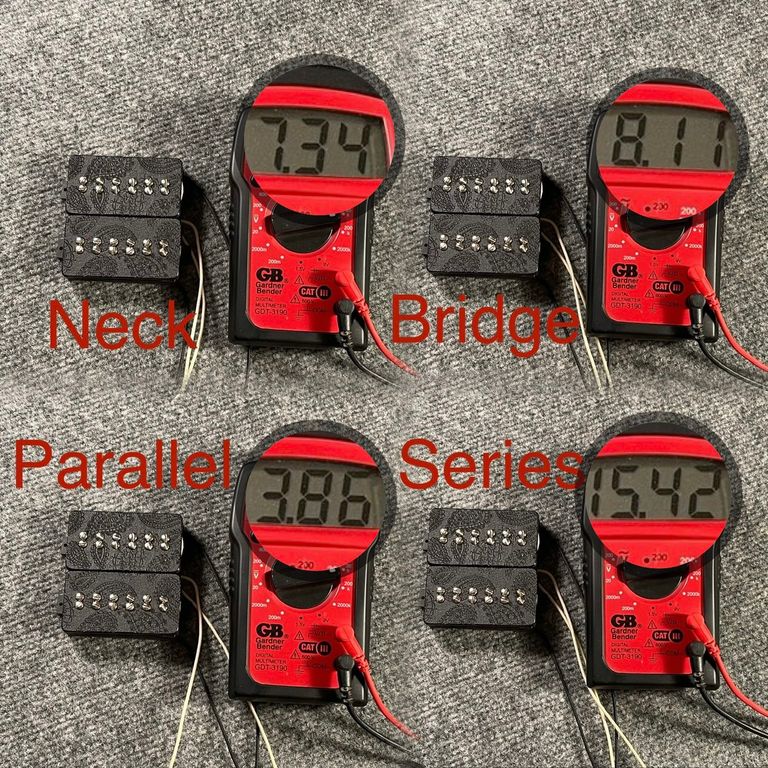
Series/Parallel
When two pickups are on, in nearly any guitar, those pickups are in parallel; the output of two pickups in parallel is approximately half of the average of both pickups (if both pickups are 8k, in parallel the output is 4k… the actual equation is 8k X 8k, divided by 16k (both resistances added together) which is still 4k; the real equation is absolutely required when the two resistances are much further apart from each other like a 30k Mudbucker and an 8k Jazz Bass pickup: 30k X 8k, divided by 38k equals 6.3k). Humbuckers too: even though humbuckers are wired in series, when two humbuckers are both on, they’re in parallel (two coils wired in series, in parallel with another two coils wired in series). When two pickups are wired in series, the signal flows through one pickup into and through the other before reaching the controls; the output is then doubled (if both pickups are 8k, in series the output is 16k). Parallel is to pickups functioning independently; series is two pickups functioning as one.
It’s hard to come up with analogies and simpler ways to explain this completely. The best I’ve come up with is two events: two TV shows on at the same time (not streaming, no DVR), in parallel, and you can’t get the full effect because you can’t watch both simultaneously so experience part of each; two TV shows happen one after another, in series, and the overall experience is greater because you experience both fully and one show enhanced the other. I’m not saying that series is better, even though that analogy basically says that. With pickups, series and parallel sound completely different even though two pickups are on in both wirings. Parallel is standard in all of your guitars; series is both pickups functioning as one big humbucker.
If two pickups are RWRP (reverse wound, reverse polarity), they will be hum-canceling but it doesn’t mean that they are a “humbucker” or wired in series. Two pickups with the same polarity and wind direction can also be wired in series for a big humbucker tone that isn’t hum-canceling. Also in-phase and out-of-phase aren’t the same as series and parallel. Two Pickups can be out-of-phase and still be wired in series.
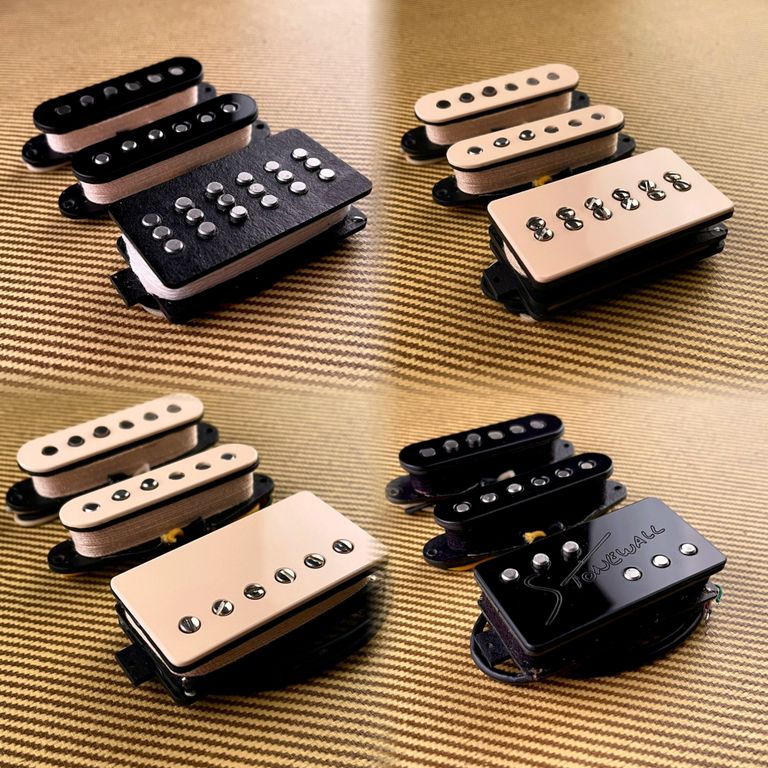
SSH Strat Questions
There are four common reasons why someone might want a humbucker in their Strat...
Reason One: thinking a humbucker is the only way to get a fatter tone out of the bridge position. But my Alternate Dimension Signature Strat set has an S90 (Strat sized P90) in the bridge position which has a bigger tone and more bass than traditional Strat bridge pickups. This is a better option because humbuckers don’t really play well with the single coils.
Reason Two: trying to get both Fender and Gibson tones out of one guitar (Strat). Unfortunately, just putting any humbucker in the bridge position of a Strat won’t make it sound like a Gibson. There are too many differences between any Gibson and a Strat: scale length, string length, neck wood, body wood, neck joint, neck angle, bridge, headstock, and more. Really, the only things they have in common are the strings and the nickel-silver fret wire. Luckily, I’ve designed a humbucker that can make non-Gibson guitars sound like a Gibson: my Alternate Dimension Extra Tone bridge humbucker. The prototype went into a less-than-six-pound Parker Nitefly which made it sound like a Les Paul. This humbucker is the only way to get a close-to Gibson tone in a Fender.
Reason Three: looking for a bigger humbucking tone(s) in a Strat but not necessarily a Gibson humbucker tone. I was looking for another way to wire three Strat pickups to help players get away from putting a humbucker in their Strat and I found (and then modified) a way to wire them in series. When two pickups are on in nearly every guitar, they’re in parallel (the output is half of the average of both pickups: if both pickups are 8k, the output is 4k when both are on). In series, the signal from one pickup flows into the other (if both pickups are 8k, the output is 16k when wired in series). With this wiring, you have your traditional 5-way pickup selector, master volume, master tone, and a 2-way toggle switch (replaces the second tone control) that switches from parallel (standard) to series. In parallel mode, everything functions exactly the way you’re used to (normal five Strat tones); in series mode, positions 1 & 2 are neck and middle in series, position 3 is guitar-off (no output/kill switch), positions 4 & 5 are middle and bridge in series. These series tones aren’t traditional humbucker tones; instead they’re fat but open humbucking tones with the snappy string response that Fender pickups have. This is the “take one guitar to the gig” setup.
Reason Four: players who have SSH routed guitars looking for new pickups. For these customers, I have four bridge pickup options: two humbucker sized single coil options — Third Eye Single Coil or Slutty Wolf H90; and two humbucker options — Alternate Dimension Wide Range Humbucker for PAF routs or Alternate Dimension Extra Tone bridge humbucker.
Check out the Alternate Dimension SSH Strat set listing and loaded pickguard listing to see you options.
Wax Potting
Pickups are “potted” in hot wax to reduce microphonic feedback. Small gaps between the pickup components and air inside the coil can allow vibrations inside the pickup which creates a very high pitched squealing feedback. That’s called microphonics (you can actually yell into these pickups and hear that through the amp)… it’s very unpleasant. “Vacuum wax potted” is the default option in the drop down menu: pickups are placed in melted wax and left alone for a few minutes to allow the pickup to reach the temperature of the wax, then it’s covered with a lid and a vacuum removes all the air and the pickups remain in the wax vacuum for a few minutes, removed to cool off, and then all the excess wax is removed. The vacuum forces the wax into all the gaps and prevents the internals of the pickups from vibrating. “Lightly potted” is the same process without the vacuum; the wax doesn’t penetrate into the coil but might fill the gaps between the other components. Lightly potted pickups are still microphonic but less microphonic than unpotted pickups; not recommended for playing in amps more powerful than 5 watts. “Unpotted” pickups are microphonic. They are more musical, because they can vibrate with body, which makes them particularly nice for recording… however, you’ll have to play sitting very still, not wearing a mechanical watch, and be careful not to hit anything but the strings when playing otherwise you’ll hear all of that in the recording: the guitar pick hitting the pickguard, your hand hitting the body, the ticking of your watch, etcetera. Vacuum wax potted is always the safest way to go.
© Copyright 2023 Stonewall Pickups. All rights reserved.
We need your consent to load the translations
We use a third-party service to translate the website content that may collect data about your activity. Please review the details in the privacy policy and accept the service to view the translations.
